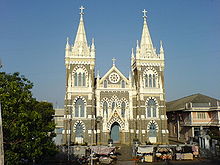Basilica of Our Lady of the Mount, Bandra
| Mount St Mary Church | |
|---|---|
| Basilica of Our Lady of the Mount | |
 | |
 | |
| 19°2′48″N 72°49′21″E / 19.04667°N 72.82250°E | |
| Location | Bandra, Bombay (Mumbai). |
| Country | India |
| Denomination | Roman Catholic |
| History | |
| Status | Minor Basilica |
| Dedication | St Mary |
| Architecture | |
| Functional status | Active |
| Completed | Rebuilt 1904 |
| Specifications | |
| Number of spires | 2 |
| Administration | |
| Archdiocese | Archdiocese of Bombay |
| Clergy | |
| Archbishop | Cardinal Oswald Gracias |
| Rector | Bishop John Rodrigues Rev Fr Michael Goveas |
Officially, the Basilica of Our Lady of the Mount, colloquially known as Mount Bandra and Mount St Mary Church; is a basilica (shrine) of the Roman Catholic Church, located at the Bandra neighbourhood of Bombay (Mumbai), India.[1]
The festival of the nativity of St Mary, also known as Holy Marymas or the Bandra Fest, is celebrated here on the 8th day of September: the auspicious occasion of the birth of the virgin-mother of Jesus Christ. The annual feast is followed by a week-long fair or fête known in the northern Konkan region as the "Bandra fair"; it is thronged by lakhs of tourists, pilgrims and devotees every year.[2][3][4] Many visitors come to Mount St Mary Church in order to make their mannat (wish) come true.[4]
Pope Pius XII granted a decree of canonical coronation to the shrine's reverenced Marian icon on 21 October 1954, both signed and notarised by Cardinal Giovanni Battista Montini of the Sacred Congregation of Rites. The statue of the Madonna and the Prince of peace was crowned in a ceremony on 5 December 1954, by the late Cardinal Valerian Gracias.
The basilica
The basilica stands on a hillock, about 80 metres above sea level overlooking the Arabian Sea. It draws thousands of devotees and pilgrims annually, especially during the Bandra Fest. Many visitors attest to the miracles worked by the supernatural power of St Mary at Mount Bandra. The shrine attracts people from all faiths who plead for favours, with others coming back expressing their gratitude. The church was raided and destroyed in 1738 during the Mahratta Invasion of Bassein, led by the Peshva Brahmin Chimaji Appa. It was rebuilt in the British Bombay era.
During the Bandra Fair, the entire area is decorated with festoons and buntings. Many pitch up stalls to sell religious articles, flowers, snacks and sweets. Wax figures of the Virgin Mary along with an assortment of candles shaped like hands, feet and various other parts of the body are sold at kiosks. The sick and the suffering choose a candle or wax figure that corresponds to their ailment or request and light it inside the church with the hope that Mother Mary will heed their appeals for help.[4]
Statue of the Virgin Mary

Although the current structure and edifice of the shrine is just 100 years old and was rebuilt in British Bombay, the history behind the current statue of the Blessed Mary goes back to the 16th century, when Jesuit priests brought the statue and constructed a chapel in what was then the Portuguese East Indies. In 1700, Sunni Arab pirates raiding the area were interested in the gilt-lined object held in the hand and desecrated the statue by cutting off the right hand.
In 1760, the church was rebuilt after the Mahratta invasion of Goa and Bombay, and the statue was substituted with a statue of Our Lady of Navigators in the St Andrew's Church nearby. Legend has it that a Koli Christian fisherman dreamt of the statue floating in the sea, and as prophesied in the dream the statue was indeed found the next day, floating in the sea. A Jesuit annual letter dated to 1669 and published in the book St Andrew's Church, Bandra (1616–1966) supports this claim. The Koli fishermen call the statue as Mot Mauli, literally meaning the "Pearl Mother or the Mother of the Mount"; Mot could be a corruption of the Indo-Portuguese word monte for "mount"; Maoli is a Marathi-Konkani word for "mother". The previous statue is now restored and is enshrined in a place of honour in the basilica. Most Bombay East Indians and some Hindus visit this shrine often, making the place a prominent feature of intercommunal harmony and interfaith dialogue in Mumbai.[5]

See also
References
- ^ Travel, D. K. (7 September 2017). DK Eyewitness Travel Guide India. ISBN 9780241326244.
- ^ Mount St Mary fair begins today[dead link] Indian Express, 8 September 2007.
- ^ Devotees throng to Bandra Fest on the opening day as stall owners protest DNA (newspaper), 13 September 2010.
- ^ a b c "Mount St Mary Church In Bandra Is Believed To Make All Your Wishes Come True". Fork Media. 31 January 2018. Retrieved 29 May 2020.
- ^ A Hindu nationalist leader at the Marian Shrine AsiaNews, 12 September 2011.
External links
![]() Media related to Mount Mary Church, Bandra at Wikimedia Commons
Media related to Mount Mary Church, Bandra at Wikimedia Commons







